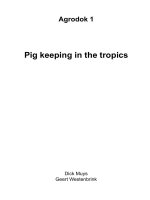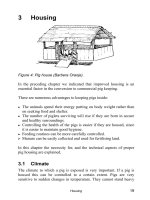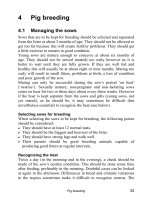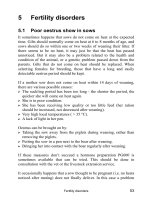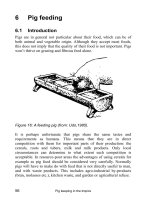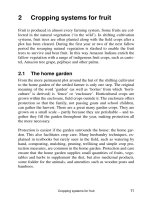Goat keeping in the tropics - Part 5 docx
Bạn đang xem bản rút gọn của tài liệu. Xem và tải ngay bản đầy đủ của tài liệu tại đây (219.97 KB, 11 trang )
Housing
47
5 Housing
Goats are kept in the tropics and subtropics as well as in temperate
areas. Within each climatic zone many more, smaller zones can be
distinguished which can differ greatly: some are dry, others wet,
sometimes this is combined with heat, in other places with cold, the
conditions can be stable but are often also extremely variable. In short,
each region has its own requirements for the housing of animals.
In this chapter, we will look at the objectives of different housing pos-
sibilities, the different ways of housing animals and the demands you
must make of a stall. At the end of the chapter, we will give you a
number of practical designs which you can use as examples when de-
signing your own stall.
5.1 Reasons for housing goats
Climate control
An important function of housing goats is to protect their health. Just
like many other (domestic) animals, goats cannot take damp nor
draughts well. With the help of good housing, a waterproof roof and
draught-proof walls to keep out damp and draughts, you will avoid
having sick goats. Goats are generally well protected against the cold
by their coat of hair. Extreme heat, on the other hand, bothers them. A
goat will search for shade by itself if it gets too hot. If no shade is to
be found, you must provide it yourself (a shelter).
Especially pregnant goats, nursing goats and their young are less ca-
pable of surviving unfavourable climatic conditions. Your must there-
fore protect such animals more.
Keeping an eye on breeding, health and feeding
Good housing makes it easier to keep an eye on your goats. You can
more easily observe and guide phenomena such as coming on heat,
mating, pregnancy and kidding when the goats are kept in a pen than
Goat keeping in the tropics
48
if they wander around freely outside (see also Chapter 1 Goat breed-
ing).
A number of disease symptoms (such as diarrhoea) can be detected
earlier when the goats are kept penned. It makes a difference whether
you house the goats individually or as a group. Within a group, a list-
less goat (caused, for example, by a severe worm infection) will be
noticed sooner. A good stall has a quarantine area where you can iso-
late goats which are sick or probably are.
An advantage of housing is that you can give each animal individually
attention and possibly better feed if necessary. For example, you can
check the feeding of pregnant or nursing animals or a weakened, sick
goat. Furthermore, there are certain feeding systems which make the
milking of goats easier (see following sections).
Safety
Preventing theft can be another reason for building a stall. It goes al-
most without saying that the stall must be solidly built and should
stand close to the house or compound. An alert watchdog can also
help.
Especially in densely populated areas, a watchful eye must be kept on
goats to prevent them from damaging crops. Sometimes this is only
necessary for a certain part of the year, when the crops are young. A
sharp watch also prevents goats from falling victim to traffic, an im-
portant cause of death among goats when there is a busy road nearby.
Collection of manure
By keeping goats inside, you concentrate their manure production and
make it easier to use.
Housing
49
5.2 A further look at housing
There are various ways of housing goats. There are good goat keepers
who only give their animals the shade and protection of a tree. There
are also those who build a large stable plus milking shed.
There is no blueprint for housing; choose for yourself that form which
best suits your situation. Build the stall in such a way that the goats
can easily live, eat and rest there. Make sure that you can work there
with pleasure.
Invest in quality
The investment in good housing may seem high at the time you calcu-
late the cost of building a stall, but it is low in comparison with the
other costs. A good stall will last a very long time and gives few prob-
lems. The really high costs are feed, labour, dead or stolen animals
and caring for sick animals. Do not save on the building and good
equipment of the stall without careful thought.
Individually or group housing
Whether you will house your animals individually or as a group is one
of the considerations when thinking about housing. In general, goats
are housed as a group because this is less labour intensive for the goat
keeper and because the building costs of the stable are lower. The goat
is a true herd animal and prefers group housing.
The size of the herd must not be too large in order to avoid unrest. If
the goats do not graze, a surface area of one and a half to two square
meters of floor space is needed per goat. If they do graze, you can get
by with one square meter per goat.
Tethering animals
If you have only few animals and if you do not want to invest much in
housing, the easiest way of keeping goats is to tether the goats. This
means you tie each goat with a rope to a stake. A disadvantage is that
the goats go round and round in circles and in doing so trample a lot
of grass. You must also move them often so that they can find new
pasture.
Goat keeping in the tropics
50
Another possibility is an exercise line (see figure 12). To make one, a
long rope is stretched between two poles. The goat has a short rope
about its neck which runs along the line with a ring. This system
works better than the one just mentioned.
Figure 12: Goat on exercise line
Partial and permanent stalling
A distinction must be made between partial and permanent stalling of
goats. In partial stalling, the goats are kept penned only at night or
during part of the day; the rest of the time they wander freely, foraging
about.
In you keep them permanently penned or stalled, you must also take
complete care of the supply of water and feed. See section 4.2.
Partial stalling has the advantages that the stall can be smaller and that
you do not have to provide all the feed and water yourself. This is only
possible if there is enough pasture in the area. In densely populated
areas with a lot of agriculture, pasture is often limited and you are
usually forced to keep your goats permanently stalled.
In both partial and permanent housing, the goats are kept within an
enclosure. Enclosures can be made of stone piles, stakes, thorns or
wire fencing (expensive!).
Planting a hedge of quick-growing shrubs or trees, such as Leucaena,
Calliandra or Glyricidia, is a possibility. Since goats eagerly eat such
Housing
51
bushes, you will initially have to protect the young plants until they
are large enough to resist being browsed.
Thorn bushes which can be found locally are also suitable for making
living hedges.
If certain goats continuously escape, put
a triangle of wood on them. This re-
stricts their passage.
5.3 Building stalls
A first decision is where to locate the
stall. It must be near the home so that
you can easily keep an eye on the goats
(important in case of disease, servicing,
kidding, etc.). You also discourage
thieves that way.
Positioning the shed
Depending on the climate, the position-
ing of the shed can be important. By
placing the longitudinal axis of the stall
east - west, you can prevent the sun
from heating the stall up too much.
If, on the other hand, you want the sun to shine on the floor so that the
floor dries up and parasites die, it is better to build the shed along a
north - south axis.
The roof is also very important for good temperature regulation. A
wide overhang prevents too much sun from shining in. In cooler cli-
mates, sunlight may actually be desirable to warm up the stall. In that
case, a large surface area of the roof facing south (in the northern
hemisphere) or facing north (southern hemisphere) is useful so that the
roof which is warmed up also warms up the stall.
Figure 13: goat with tri-
angle
Goat keeping in the tropics
52
Figure 14: positioning of the shed
Ventilation
In warm climates the shed will heat up due to sunshine. Also goats
radiate heat when digesting their feed. If the animals cannot get rid of
that heat because the surrounding temperature is too high, they eat less
and therefore produce less.
Good ventilation is therefore necessary. Make the shed sufficiently
high and make sure there are openings for ventilation in the roof or
walls.
Ventilation also provides fresh air and carries away damp air. How-
ever, please note: ventilation is good, but draughts are bad! The venti-
lation openings must therefore be placed high enough so that air does
not blow directly past the animals (draught).
Housing
53
In warmer climates, where the stalls are fairly open, a low wall (of
about 1 meter) on the side the wind comes from is sufficient.
A hedge can also fulfil this function.
Figure 15: Ventilation in stall
In wet climates, it is important that the roof is waterproof and has a
large enough overhang to prevent rain from blowing in. Clues for a
suitable way of achieving this can be found in the way the roofs of
local houses are constructed.
The floor
The floor of the stall must be easy to keep clean and should stay dry. A
damp and dirty floor stimulates the development of all kinds of germs
and worms. The goats also get wet and dirty, cool down too much, are
susceptible to disease and produce poorly.
Goat keeping in the tropics
54
? If the foundation consists of sand, urine is absorbed well. Raking
away faeces every day prevents the floor from silting up.
? A hard clay or loam floor has the advantage that it is easily cleaned.
? By making the floor slope slightly, urine will flow to one side into a
drain. This can lead to another drain going around the stall which
prevents rainwater from flowing into the stall.
? In the wet tropics, you can best make a grid floor using bamboo or
wooden slats (see figure 16).
Figure 16: Two types of grid floor: Bamboo and wooden slats
You can put bedding (litter) on the floor in order to keep the animals
clean and to provide good insulation in a cold climate or season. Any
type of dry organic material can be used as bedding. It can be straw,
weeds, dry grass or leaves, sawdust, etc. Bedding soaks up urine and
droppings, it as advisable to add enough new bedding once a week so
that all urine is soaked up. The mixture of bedding, urine and drop-
pings piles up and has to be removed after some time. This mixture
makes very good compost which can be used on the homegarden or
field. See also Agrodok 8: ‘Preparation and use of compost’.
On litter, however, the hooves of the animals grow very rapidly. These
must therefore be cut back regularly (see Appendix 2: Hoof care).
5.4 Requirements of the installation
When talking about a shed for a group of goats, there are a number of
situations in which you need to separate a goat: during kidding, rais-
ing, illness and milking. Feeding and watering also require special
facilities.
Housing
55
? The kidding of goats can best take place in a separate pen, so that
the young kids are born in clean, warm and safe surroundings. The
pen must be large enough for the prospective mother plus someone
who may have to take care of her. A pen of two by two meters will
usually suffice.
? When raising young animals, it may sometimes be necessary to
keep them apart during the first three months of their lives. In larger
herds, there is a danger that small animals will be trampled by the
larger ones or that they will lose their mothers. When grazing on
difficult or dangerous terrain, kids can get hurt or lost. Make a
clean, dry and draught-free pen in the stall.
? Sick animals must be removed from the herd to prevent further in-
fection and to be better able to care for and observe them. A sepa-
rate pen is ideal for this
purpose.
Both the “sick-bay” as well
as the kidding and raising
pen must be kept extra
clean.
Milking facilities
To facilitate milking, goats
are placed on a platform so
that you have easy access to
the udder. With the help of a
feeding rack you can con-
strain them and at the same
time feed them. See next
section for these feeding
racks. To get good quality
milk, hygiene is very im-
portant.
Figure 17: platform for milking with
feeding rack
Goat keeping in the tropics
56
Feeding and drinking facilities
In each housing system, the
supply of water and feed is
of great importance.
Spreading feed on the floor
causes it to be trampled, get
dirty and reduces the qual-
ity of the feed.
Hence the great usefulness
of a manger. The goats eat
their fodder from the man-
ger with raised heads, with-
out the feed touching the
floor.
Materials which can be used include wooden poles or planks, metal
rods, harmonica netting (mesh width 5 x 5 cm), etc. Make sure that
green fodder has been partially dried, wet feed is poorly assimilated.
See also figure 8 in Section 4.2.
When giving high quality feed, some animals can miss out on it, espe-
cially since you usually hand it out in small quantities and the strong-
est goats take everything for themselves. You can avoid this with a
feeding rack. With such a rack each animal has its own feeding spot
(See figure 19).
Figure 19: Feeding rack with beam
Figure 18: Goat eating from a man-
ger (Adapted from: Peacock, 1996)
Housing
57
When the goats have placed their heads through the rack, you lower
the plank so that the goats are fastened. The plank is secured with a
chock. In an alternative construction you use a plank which you slide
into place over the heads of the goats.
A feeding passage or trough which lies above the level of the stall
floor makes cleaning easier. A raised placement also prevents goats
from standing in it or their droppings getting in it.
Watering troughs
Putting the trough on placement in order to prevent the goats from
standing in it or making it dirty, is also true for the placement of
watering troughs. Fencing around the troughs ensures that the goats
can reach the water but cannot contaminate it.
Always make sure there is clean drinking water for the animals. On
warm days a goat will use about 4 litres of water per day if it gets dry
feed (see also Chapter 4 on Nutrition and Feeding).
‘Think ahead’
Also when building sheds it is well to heed the saying: Look before you leap.
Go and look at sheds of other goat keepers in the surroundings and try to un-
derstand why things were built the way they are and using those specific ma-
terials.
Ask for advice when choosing local materials. If you use wood or bamboo,
you will be faced with rotting, especially in the humid tropics. It is advisable to
treat the wood or bamboo before use.


